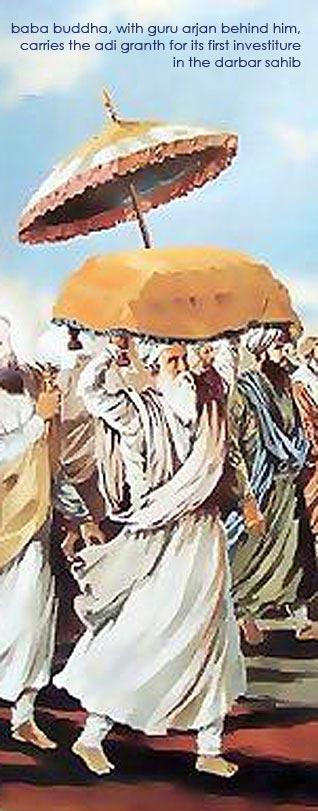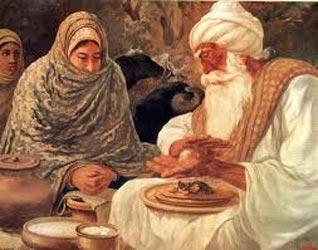Our Heroes
Baba Buddha: Grand Old Man of Sikhdom
by GURDIP SINGH RANDHAWA
Baba Buddha (1506 -1631), a most venerated and primal figure of early Sikhism, was born on October 6, 1506 at the village of Katthu Narigal, 18 km northeast of Amritsar, Punjab.
Bura, as he was originally named, was the only son of Bhai Suggha and Man Gauran. As a small boy, he was one day grazing cattle outside the village when Guru Nanak happened to pass by. According to Bhai Mani Singh ("Sikhan di Bhagat Mala"), Bura went up to him and, making obeisance with a bowl of milk as his offering, pleaded to him in this manner:
"O sustainer of the poor! I am fortunate to have had a sight of you today.Absolve me now from the cycle of birth and death."
The Guru said, "You are only a child yet. But you talk so wisely."
"Once some soldiers set up camp by our village," replied Bura, "and they mowed down all our crops ripe as well as unripe. Then it occurred to me that when no one could check these indiscriminating soldiers, who would restrain Death from laying his hand upon us, young or old."
At this Guru Nanak pronounced the words : "You are not a child; you possess the wisdom of an old man." From that day, Bura, came to be known as Bhai Buddha, 'buddha' in Punjabi meaning an old man, and later, when advanced in years, as Baba Buddha.
Bhai Buddha became a devoted disciple. His marriage at the age of seventeen at Achal, 6 km south of Batala, Punjab, did not distract him from his chosen path and he spent more time at Kartarpur where Guru Nanak had taken up his abode than at Katthu Nangal.
Such was the eminence he had attained in Sikh piety that, at the time of installation of Bhai Lahina as Guru Angad, i.e. Nanak II, Guru Nanak asked Bhai Buddha to apply the ceremonial tilak on his forehead.
Bhai Buddha lived up to a ripe old age and had the unique honour of anointing all of the four Gurus that followed Guru Nanak.
He continued to serve the Gurus with complete dedication and remained an example of holy living for the growing body of disciples. He devoted himself zealously to tasks such as the digging of the baol at Goindval under the instruction of Guru Amar Das and the excavation of the sacred tank at Amritsar under Guru Ram Das and Guru Arjan.
The ber tree under which he used to sit supervising the excavation of the Amritsar pool still stands in the precincts of the Golden Temple. He subsequently retired to a bir or forest, where he tended the livestock of the Guru ka Langar. What is left of that forest is still known, after him, as Bir Baba Buddha Sahib.
Guru Arjan placed his young son, Hargobind, under Bhai Buddha's instruction and training. When the Adi Granth (Granth Sahib) was installed in the Harmandar on August 16, 1604, Bhai Buddha was appointed the first granthi by Guru Arjan. He thus became the first custodian of the sacred shrine, now known as the Darbar Sahib or Golden Temple. Following the martyrdom of Guru Arjan on May 30, 1606, Guru Hargobind raised opposite the Harimandar a platform called the Akal Takht, the Timeless Throne or the Throne of the Timeless, the construction of which was entrusted to Baba Buddha and Bhai Gurdas, no third person being allowed to take part in it.
On this Takht, Bhai Buddha performed, on June 24, 1606, the investiture ceremony at which Guru Hargobind put on two swords, one on each side, symbolizing miri and piri, sovereignty and spiritual eminence, respectively.
Baba Buddha passed his last days in meditation at Jhanda Ramdas, or simply called Ramdas, a village founded by his son, Bhai Bhana, where the family had since shifted from its native Katthu Nangal. As the end came, on November 16, 1631, Guru Hargobind was at his bedside. The Guru, as says the Gurbilas Chhevin Patshahi, gave his shoulder to the bier and performed the last rites.Bhai Gurdas, further to quote the Gurbilas, started a reading of the Adi Granth in memory of the deceased.
The obsequies concluded with Bhai Gurdas completing the recital and Guru Hargobind presenting a turban to Bhai Buddha's son, Bhana. Two shrines stand in Ramdas commemorating Baba Buddha, Gurdwara Tap Asthan Baba Buddha Ji, where the family lived on the southern edge of the village, and Gurdwara Samadhan, where he was cremated.
[Courtesy: The Sikh Encyclopaedia, Edited by Harbans Singh]
September 9, 2010
Conversation about this article
1: Sangat Singh (Kuala Lumpur, Malaysia), September 09, 2010, 8:21 PM.
When Bhai Lehna became Guru Angad, Bhai Buddha in all humility asked Guru Angad to give him 'Updesh'. Guru Angad's reply in the form of a shabad is enshrined in the Guru Granth Sahib: "Tin ka-o kia-aa updaysee-ai jin Guru Naanak day-o" - "What teachings can be imparted to those who were blessed with the Divine teachings of Guru Nanak himself".
2: G. Singh (U.S.A.), September 10, 2010, 1:01 PM.
We were going to Asia for work-related travel and figured we might as well take a short trip to Punjab. We were there for only four days, so we went to see our family in Amritsar. My oldest Aunt, whom everyone calls Jhai ji, and her family, lives there. Next morning, as we are making plans to visit other relatives around Punjab and visit Harmandar Sahib, she tells me that you have to take Nohn (daughter-in-law) to Bir Baba Buddha Ji! My wife had never been there, so we figured it's a great idea. But my sister who was taking us around for these few days is worried that it's a little outside the city and we may lose a day just taking a trip there and then going to Sheharta Sahib Gurdwara. But we had already decided to take the trip anyway. Just then, Jhai Ji insists, no she also has to make missie de parshaadey and take some gande (onion) along to Bir Baba Buddha Ji! I have heard the story of Mata Ganga Ji going there and being blessed for a son by Baba Buddha Ji but wasn't aware that it's a tradition. My wife looks at me a little puzzled as she does not know how to make missie de parshaadey. I explained to her the significance. So she goes in the kitchen to make them and we take them along with some gande to Bir Baba Buddha Ji. We head to the gurdwara and I see many other devotees bringing large quantities of parshaadey. We offer langar and then sit next to the sarovar eating missie de parshaadey and gande for langar. We are back in the U.S. and a few months later we find out my wife is pregnant. We have a daughter but had difficulties with her pregnancy and were delighted just having her. So, this news was quite a pleasant surprise. This time, we have a son! I tell my wife that Baba Buddha Ji must have blessed her right away, considering she barely knew how to make decent missie de parshaade!
3: Daljeet (India), September 21, 2010, 10:53 PM.
Wow! The prophecy lives on ... My maammi (aunt) was also blessed with a son after visiting Shayata Sahib.




